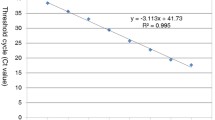Abstract
A Real Time PCR system (Q-PCR) for the detection and quantification ofAspergillus flavus in black pepper has been used. Thenor1 gene, a gene of the aflatoxin biosynthetic pathway, served as target sequence. The determined copy numbers of thenor1 gene were compared to the cfu numbers obtained by plate counting. There was not a direct correlation of the results with both approaches, however the tendency was the same. In general both values increased with prolonged incubation time. The differences in copy numbers of thenor1 gene to cfu numbers decreased with increasing incubation time.
Zusammenfassung
Aspergillus flavus wurde mittels Real Time PCR (Q-PCR) in schwarzem Pfeffer nachgewiesen und quantifiziert. Als Zielsequenz wurde dasnor1 Gen angewandt, das für die Biosynthese von Aflatoxin von Bedeutung ist. Die Q-PCR Ergebnisse wurden mit den cfu-Werten verglichen. Bei längerer Lagerung steigen beide Werte an. In der Regel sind die Q-PCR Ergebnisse höher als die cfu-Werte. Die Differenz wird jedoch bei längerer Inkubation des schwarzen Pfeffers geringer.
Similar content being viewed by others
References
Mayer Z, Bagnara A, Färber P, Geisen R (2001) Quantification of an Aflatoxin producing strain ofAspergillus flavus in foods by Real time PCR. J Food Protec, submitted
Bartine H, Tantaoui-Elaraki A (1997) Growth and toxigenesis ofAspergillus flavus isolates on selected spices. J. Environ. Pathol. Toxicol. Oncol. 16: 61–65
Bennett JW, Papa, KE. (1988) The aflatoxigenicAspergillus spp. Adv Plant Pathol 6: 263–280
Färber P, Geisen R, Holzapfel WH (1997) Detection of aflatoxinogenic fungi in figs by a PCR reaction. Int J Food Microbiol, 36: 215–220
Jelinek CF, Pohland, AE, Wood GE (1989) Worlwide occurence in foods and feeds-an update.J Assoc off Anal Chem 72: 223–230
Loeffler J, Henke N, Hebart H, Schmidt D, Hagmeyer L, Schumacher U, Einsele H (2000) Quantification of Fungal DNA by Using Fluorescence Resonance Energy Transfer and the Light Cycler System. J Clin Microbiol 38: 586–590
Pittet A (1998) Natural occurence of mycotoxins in foods and feeds-an updated review. Revue Vet Med 149: 479–492
Rossen L, Norskov P, Holmstrom K, Rasmussen OF (1992) Inhibition of PCR by components of food samples microbial diagnostic assays and DNA-extraction solutions. Int J Food Microbiol 17: 37–45
Shapira R, Paster N, Eyal O, Menasherov M, Mett A, Salomon R (1996) Detection of aflatoxinogenic molds in grains by PCR. Appl Environ Microbiol 62: 3270–3273
Trail F, Chang PK, Cary JW Linz J 1994 Structural and functional analysis of thenor-1 gene involved in the biosynthesis of aflatoxins byAspergillus parasiticus. Appl. Environ. Microbiol. 60: 4078–4085
Author information
Authors and Affiliations
Rights and permissions
About this article
Cite this article
Bagnara, A., Mayer, Z. & Geisen, R. Quantification ofAspergiullus flavus BFE96 by sybr green Q-PCR in black pepper. Mycotox Res 16 (Suppl 2), 244–247 (2000). https://doi.org/10.1007/BF02940049
Issue Date:
DOI: https://doi.org/10.1007/BF02940049




